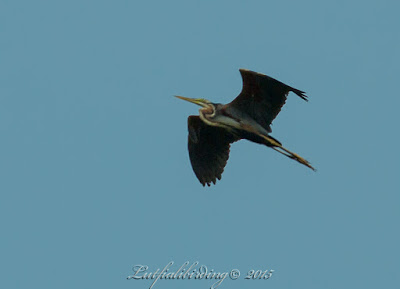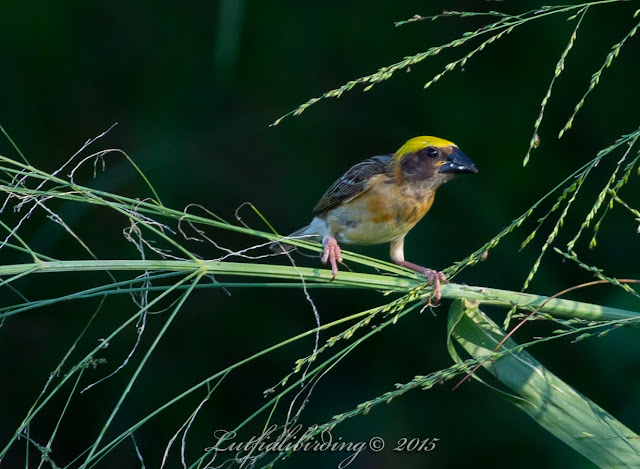The Tasik Timah Tasoh (Tasik = Lake) is a man-made lake created to store water for irrigation to the surrounding paddy fields and also to control flood up stream in the state of Perlis. Like any man-made lakes there will be areas inundated and become wetlands, small islands, dead trees which attract birds, some are migratory birds during winter time up north.
This lake is roughly 6 KM from my in-laws's house and is easily accessible from the main road going toward Padang Besar, the most northern of Malaysian towns bordering Thailand.
I have visited this lake many times in the past for some freshwater fishing mostly. This time
is the first time i went there for just to photograph birds. So i did not know what to expect. I did two separate trips over two days.
DAY 1:
My first trip with my 14 years old daughter, Tasha, was just about an hour as it had been raining in the afternoon. We were first greeted by a White-throated Kingfisher on a concrete electric pole along the entrance road to the Lakeview Resort located on a small hill overlooking the lake. The resort is quite good for those who want to be close to nature.
Then going further deeper into the lake area we saw a Lesser Coucal perching on a bamboo tree by the bank of the lake. I had about less than 30 seconds to take a few shots before it flew away. I must say driving a silvery 4x4 is not good to keep a low profile, a dark or olive green-colored vehicle is better as Coucals are cautious birds.
 |
| Lesser Coucal |
At this T-junction there are two dead-end roads going to the left and the right. Both end up in the lakes as they used to cross the lake area leading to a few villages before the lake was created. I took the one leading to the right because i went there before to fish for Snakeheads aka Haruans. There is a Malay cemetery at the point where the road started to submerge into the lake, kind of spooky even during the day because the spot is very secluded, you either get spooked by an apparition or mugged by the ones on motorcycles! But the view you get at the end of the road is worth the risk.
 |
| A fisherman boat passes by with the background showing the mountain range bordering Thailand |
 |
| Another view of the lake surrounding |
 |
| Typical floating vegetation along the edge of the lake, great for birds, waders, ducks etc |
We saw a few lifers what looked like ducks swimming in the middle of the lakes, sometimes diving for small fishes. I had never seen ducks like them before, upon enlarging the image they turn out to be Little Grebe which i think are migrants, not sure from the South or North.
 |
| Little Grebe enjoying their holiday |
While observing the Little Grebe a Purple Heron flew up over me, i managed to take a couple of shots.
As the light started to fall off we decided to go home. On the way out we came across a White-breasted Waterhen known locally as Burung Ruak-Ruak trying to cross the road.
DAY 2:
The next day i went to the same place again with my wife and my six years old Soraya around noon. But this time i explored the opposite dead-end road on the left. There is a small cove at the T-junction where a boat was tied, i noticed a big white bird with long legs but not an Egret. It flew away as i was approaching to take a shot.
 |
| Birds are not the only attractions here |
At the end of the road the scenery is different from the other side, there is no cemetery but more like a wetland with marshes and small islands.
Soraya straight away got into actions, but using a 24-105mm L zoom lens was too short to photograph small birds far away, but it was good to keep her excited and interested.
 |
| Too hot daddy, i am going back into the car! |
I noticed a bird flying fast across the lake, i selected a central group AF points, set shutter to 1/2000 sec, snap snap snap snap while panning, got it! A White-throated Kingfisher again.
There were also a few Little Grebe on this side of the lake. There must be a lot more of them than i thought. These must be what Soraya was trying to photograph before she gave up because of the heat.
On the way back suddenly a big white bird flew over me while i was trying to photograph a Lesser Coucal near a bush. I practically had to shoot while doing a 180 degrees turn and panning at the same time. I was lucky to get a few sharp photos. It turn out to be a Red-wattled Lapwing.
The Timah Tasoh Lake is a huge area to do birding and i am sure i could have gotten more species on record had i spent a couple more days exploring the edges of the lake. However, there were other sites i needed to try before my holiday was over. I am sure i could visit it again, for God sake it is only 6 KM from my in-laws's house and just a 15 minutes drive, so no worries. I would recommend you give it a try and explore it yourself.
Thanks for reading, happy birding.





















































